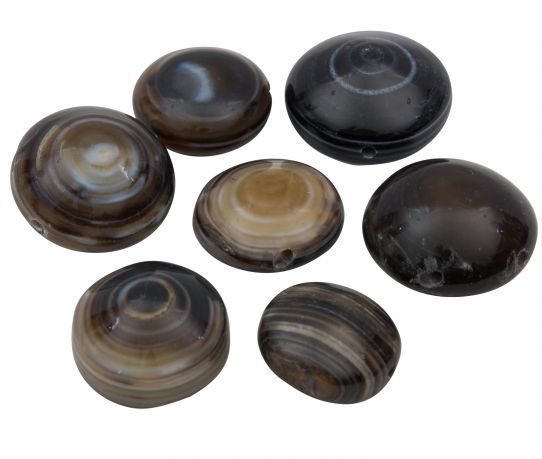We use cookies to make your experience better.
Eye Agate in Onyx/Carnelian(25-35mm) also called "Bulls-eyes" called from Mexico
Bull's eye agate comes to his name because it looks like the big eye of a bull.
Agate is a transparent, but sometimes also opaque variety of quartz and a sub-variety of chalcedony. The chemical structure of agate is identical to jasper, flint, horn and is often found together with opal. The colorful, striped specimens are used as semi-precious stones. The name agate comes from the Greek Ἀχάτης, Achatès, the name of the current Dirillo River in the south of Sicily, where agates and other chalcedones were found. Traditionally, agate was worn as a lucky stone or for healing. Agate consumables such as buttons were also made. A number of medicinal effects are given to agate, such as protection during pregnancy, headache, skin disorders and balance disorders. Agate, according to various literature, belongs to the constellations Aquarius, Taurus, Scorpio and Gemini. Agate compounds form as solution of silicic acid in cavities in older rocks. The stones can be artificially stained to obtain color combinations that are more vivid than those found in nature. The main sources of agate are Brazil, Uruguay and the United States (Oregon, Washington and around Lake Superior). Nearer the Netherlands and Belgium agate is also found in the Hunsrück in Germany.
Chemical composition: SiO2 + Al, Ca, Fe, Mn Crystal system: belongs to chalcedony-like quartz crystals, trigonal. Splitting: none. Color: light blue or gray but it can also be green Stripe color: none. Gloss: glass gloss, matt, satin gloss. Hardness (Mohs): 6.5 to 7. Average density: 2.65 kg / dm3. Transparency: transparent to translucent.
The history of amulets
For centuries, certain values have been assigned to amulets and talismans all over the world. Nowhere is the trade and walking of amulets as big as in Thailand. The use goes back to far before our era. With the emergence of Buddhism, reliquaries of deceased monks and relatives were preserved, these were contributed as a memory but also as protection and as a good luck charm. It was not only bits of clothing or hair of the deceased but also bones or teeth. Some stupas, chedi's or pagodas are claimed to contain bones or hair from The Buddha himself. To date, many pilgrims are still going to these grave monuments.
Throughout the centuries, Buddhism has received a large following and only in Thailand and tens of thousands of temples have been built, and hundreds of pilgrimages have been created from very well-known to lesser known. All these temples and places have one thing in common, each temple has its own amulet, with its own story and its own history. There are a dozen very well-known monks in Thailand who have been given the status "Buddha" in their lives by gaining the enlightenment. All these monks have meant something for the Thai population, causing sickness, poverty, and disaster to disappear or disappear. There are hundreds of stories about which are told with the most beautiful smells and colors. The earlier monks of centuries ago did not yet have a permanent residence, such as a temple or monastery. She traveled through the country to proclaim the teachings of Buddha. They sometimes slept in monasteries or with the locals, but mostly in the open air or in caves where they prayed and meditated.












